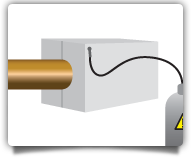
Traditionally, when an interference fit is required, fitting a component into another is done either through the force fit method or expanding the external component with heat. Mechanical damage between the two faces can occur through force fitting, while heat expanding can cause local damage or stress due to uneven or poor heating procedures. Heat expanding also carries impracticalities of heating large frames or housings.
Shrink fitting is the method of employing a cryogenic agent to shrink components including shafts, tappets, or sockets to achieve a successful interference fit. Not only is shrink fitting an efficient and cost effective method, but it eliminates the risk of damage compared to heating the external components such as gear wheels, or housings.

When parts are oversize and need to fit.

Liquid nitrogen is fed into a containment unit that isolates the area to be fitted.

The shrinking permits fitting of slightly oversized metal items into mating parts